Bathing a toddler can be a challenging task for many parents. As a parent, you want to ensure that your child is clean and healthy, but you also don’t want to overdo it. So, how often should you bathe a toddler? The answer is not as straightforward as you might think.
Understanding the Basics of Toddler Bathing is the first step in determining how often you should bathe your child. Toddlers are more active than infants and tend to get dirtier, but they also have more sensitive skin. Choosing the Right Bath Products and Setting the Right Water Temperature can make a big difference in your child’s skin health. Bathing too frequently or using harsh products can strip the skin of natural oils, leading to dryness and irritation.
Bathing Frequency and Skin Conditions are other important factors to consider. While some toddlers may need a bath every day, others may only need a bath a few times a week. Skin conditions such as eczema or dermatitis may require a different bathing schedule or specific products. It’s important to consult with your child’s pediatrician if you have any concerns.
Key Takeaways
- Understanding your toddler’s skin type and conditions is crucial in determining their bathing frequency and the right products to use.
- Bathing too frequently or using harsh products can lead to dryness and irritation of the skin.
- It’s important to consult with your child’s pediatrician if you have any concerns about their bathing routine or skin health.
Understanding the Basics of Toddler Bathing
Bathing a toddler can be a challenging task, especially for new parents. Establishing a routine for toddler bath time can make the process easier and more enjoyable for both the child and the parent. In this section, we will cover the basics of toddler bathing and provide tips for creating a successful bath time routine.
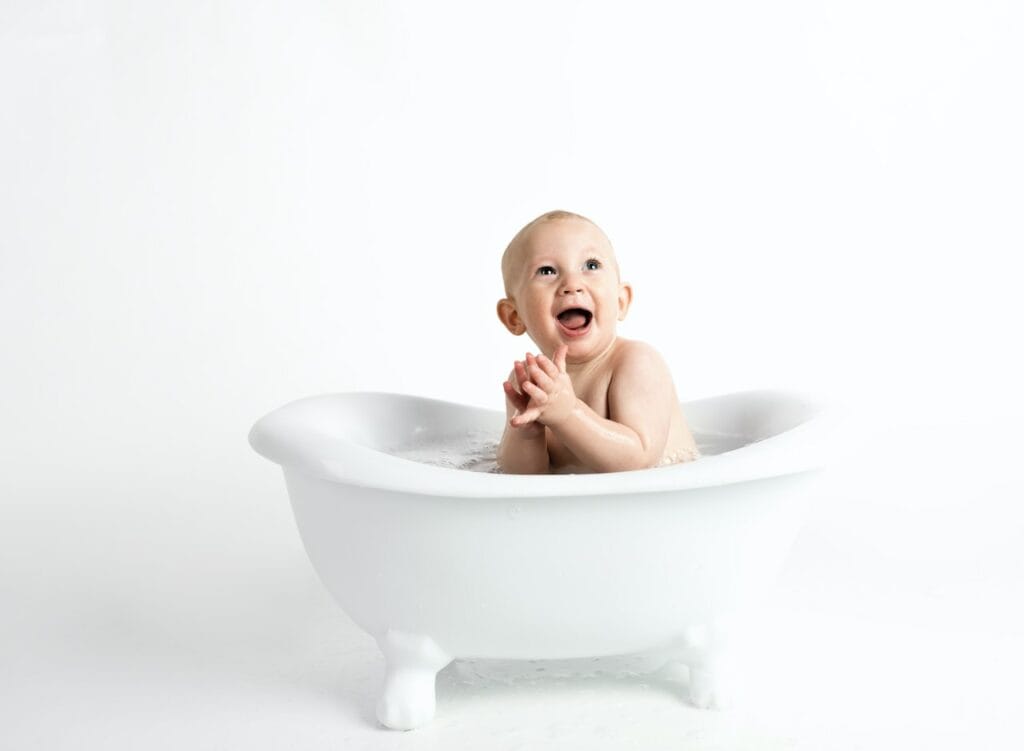
Frequency of Toddler Bathing
The frequency of toddler bathing depends on the child’s age, activity level, and personal hygiene. While infants require daily baths, toddlers can typically be bathed two to three times a week. However, if your toddler is particularly active or prone to getting dirty, you may need to bathe them more frequently.
Preparing for Toddler Bath Time
Before beginning toddler bath time, it is important to gather all necessary supplies, including a non-slip bath mat, baby wash, shampoo, and a soft washcloth. Fill the tub with warm water, making sure the temperature is not too hot or too cold. A good rule of thumb is to aim for a water temperature around 100 degrees Fahrenheit.
Bathing Your Toddler
When bathing your toddler, it is important to be gentle and patient. Use a soft washcloth to wash their face and body, being careful to avoid getting water and soap in their eyes. Use a mild baby wash and shampoo to avoid irritating their sensitive skin. Once you have finished washing your toddler, rinse them thoroughly with warm water and wrap them in a soft towel.
Creating a Successful Bath Time Routine
Establishing a routine for toddler bath time can help make the process more enjoyable for both the child and the parent. Try to choose a consistent time of day for bath time and stick to it as much as possible. This can help your child develop a sense of routine and predictability. Additionally, incorporating bath time into a calming bedtime routine can help your child relax and prepare for sleep.
In summary, understanding the basics of toddler bathing can help make the process easier and more enjoyable for both the child and the parent. By establishing a routine for toddler bath time and using gentle, patient techniques, you can create a positive experience that your child will look forward to.
Choosing the Right Bath Products
When it comes to bathing toddlers, choosing the right bath products is crucial. The right products not only ensure that your child stays clean and healthy but also help make bath time fun and enjoyable. Here are some things to consider when choosing the right bath products for your toddler.
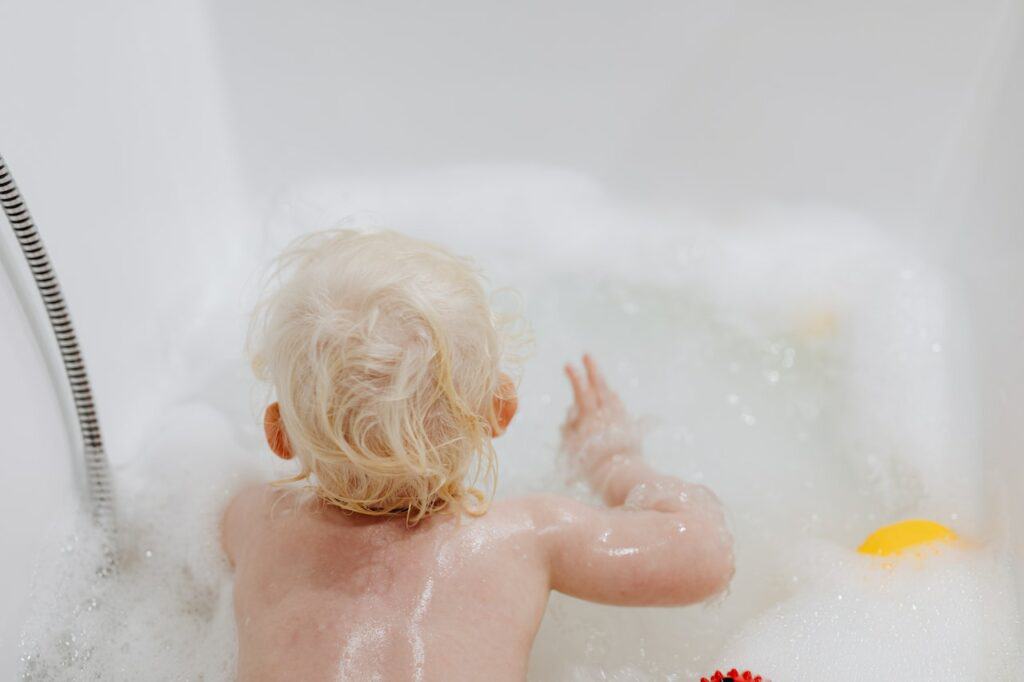
Choosing the Right Shampoo
When choosing a shampoo for your toddler, it’s important to look for one that is gentle and mild. Harsh shampoos can strip the natural oils from your child’s hair and scalp, leading to dryness and irritation. Look for shampoos that are specifically designed for children, as they are usually formulated to be gentle and mild.
Some things to look for when choosing a shampoo for your toddler include:
- Natural ingredients such as chamomile, lavender, and aloe vera
- pH balanced formulas
- Tear-free formulas
Choosing the Right Soap
When it comes to choosing a soap for your toddler, it’s important to look for one that is gentle and mild. Harsh soaps can dry out your child’s skin and cause irritation. Look for soaps that are specifically designed for children, as they are usually formulated to be gentle and mild.
Some things to look for when choosing a soap for your toddler include:
- Natural ingredients such as chamomile, lavender, and aloe vera
- pH balanced formulas
- Fragrance-free or lightly scented formulas
Bath Toys
Bath toys can make bath time fun and enjoyable for your toddler. When choosing bath toys, look for ones that are safe and age-appropriate. Avoid toys with small parts that can be a choking hazard.
Some popular bath toys for toddlers include:
- Rubber ducks
- Bath crayons
- Bath books
- Floating boats
Overall, choosing the right bath products for your toddler can make bath time a fun and enjoyable experience for both you and your child. By looking for gentle and mild products that are specifically designed for children, you can ensure that your child stays clean and healthy while also enjoying bath time.
Setting the Right Water Temperature
When it comes to bathing a toddler, setting the right water temperature is crucial. The water should be warm, but not too hot, to avoid scalding or burning the child’s delicate skin.
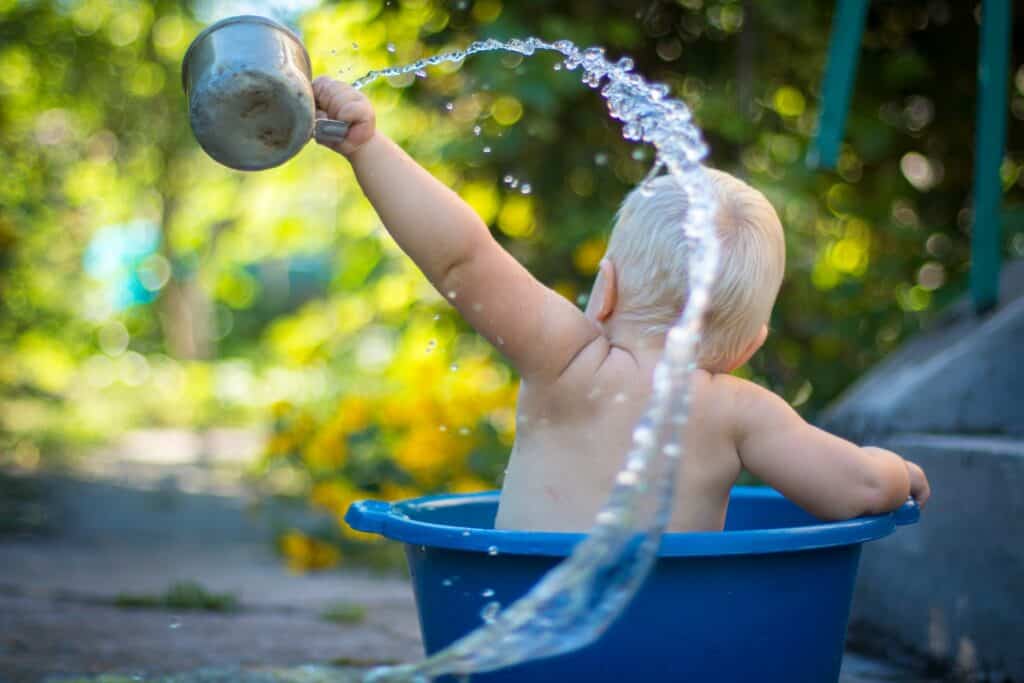
The ideal water temperature for a toddler’s bath is around 37°C (98.6°F), which is close to the child’s body temperature. You can use a thermometer to check the water temperature before placing your child in the tub. Alternatively, you can use your elbow or the back of your wrist to test the water temperature. If it feels too hot, add some cold water to bring the temperature down.
It’s important to note that hot water can be dangerous for toddlers. According to the American Academy of Pediatrics, hot tap water can cause severe burns in just seconds, especially in young children. Therefore, it’s recommended to set your water heater thermostat to 49°C (120°F) or lower to prevent accidental burns.
In addition to setting the right water temperature, you can also make bath time more enjoyable for your toddler by adding some fun bath toys or bubbles. However, be sure to choose age-appropriate toys and avoid anything that could be a choking hazard.
Overall, setting the right water temperature is a crucial step in ensuring your toddler’s safety and comfort during bath time. By following these simple tips, you can make bath time a fun and enjoyable experience for both you and your child.
Bathing Frequency and Skin Conditions
Bathing Frequency for Toddlers with Normal Skin
Toddlers with normal skin can be bathed every day if desired. However, it is not necessary to bathe them every day as long as they are kept clean and their diaper area is cleaned regularly. Bathing every other day or every two to three days is sufficient for most toddlers with normal skin.
Bathing Frequency for Toddlers with Sensitive Skin
Toddlers with sensitive skin may need to be bathed less frequently than those with normal skin. Bathing once or twice a week may be sufficient for toddlers with sensitive skin. Over-bathing can strip the skin of its natural oils, leading to dryness and irritation. It is important to use mild, fragrance-free soap and avoid hot water when bathing toddlers with sensitive skin.
Bathing Frequency for Toddlers with Skin Conditions
Toddlers with skin conditions such as eczema may require a different bathing routine than those with normal or sensitive skin. Bathing too frequently can exacerbate eczema symptoms, so it is recommended to bathe toddlers with eczema no more than two to three times per week. It is important to use a gentle, fragrance-free soap and avoid hot water. After bathing, pat the skin dry and apply a moisturizer to help prevent dryness and itching.
Overall, the frequency of bathing for toddlers depends on their skin type and any skin conditions they may have. It is important to use gentle, fragrance-free products and avoid over-bathing to prevent dryness and irritation. If you have any concerns about your toddler’s skin, consult a pediatrician or dermatologist for guidance.
Importance of Bath Time Activities
Bath time is an essential part of a toddler’s daily routine. It not only helps to keep them clean but also provides an opportunity for parents to interact and bond with their children. Here are some reasons why bath time activities are crucial for toddlers:
Promotes Hygiene
Toddlers tend to get dirty very quickly, and regular baths help to maintain their hygiene. Bathing removes dirt, sweat, and bacteria from their skin, reducing the risk of infections and illnesses. Parents should bathe their toddlers at least once a day, preferably before bedtime.
Encourages Relaxation
Bath time can be a relaxing activity for toddlers. Warm water and a calm environment can help to soothe them and prepare them for sleep. Parents can add some bath toys or bubbles to make the experience more enjoyable.
Enhances Sensory Development
Toddlers love to explore and discover new things. Bath time provides an opportunity for them to engage in sensory play. Parents can introduce different textures, colors, and scents to stimulate their senses and encourage their curiosity.
Fosters Bonding
Bath time is an excellent opportunity for parents to bond with their children. It provides a one-on-one interaction where parents can talk, sing, and play with their toddlers. This helps to strengthen the parent-child relationship and build trust.
In conclusion, bath time activities are essential for toddlers’ hygiene, relaxation, sensory development, and bonding with parents. It is a daily routine that should be enjoyed by both children and parents.
Post-Bath Care for Toddlers
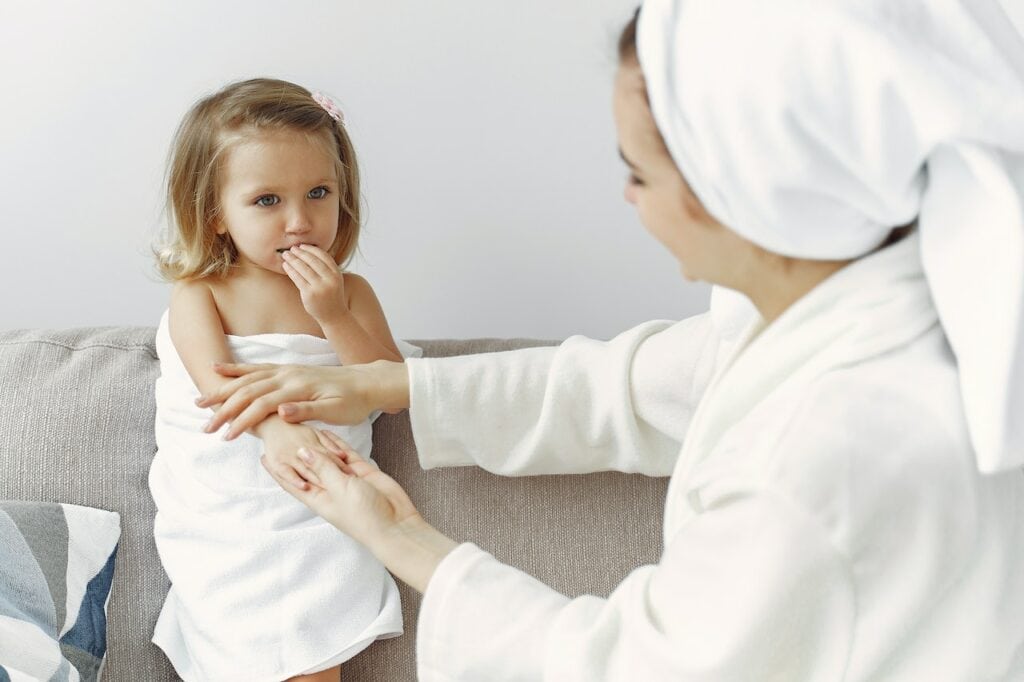
Drying and Moisturizing
After bathing your toddler, it is essential to dry them thoroughly. Use a soft towel to pat them dry, paying extra attention to the folds of their skin. Avoid rubbing the towel too harshly, as this can irritate the skin and cause discomfort.
Once your toddler is dry, it is recommended to apply a moisturizer to their skin to keep it hydrated. Look for a moisturizer that is specifically designed for toddlers and is free from harsh chemicals. Oils such as coconut oil or olive oil can also be used to moisturize the skin, but make sure to do a patch test first to avoid any allergic reactions.
Hair Care
When it comes to hair care for toddlers, it is recommended to use a mild shampoo that is gentle on their delicate scalp. Avoid using adult shampoos, as they can be too harsh and cause irritation. It is also important to rinse the shampoo thoroughly to avoid any residue buildup.
After washing their hair, gently pat it dry with a towel. Avoid using a hairdryer, as the heat can damage their hair and scalp. If your toddler has curly or tangled hair, use a wide-toothed comb to detangle it gently. You can also use a leave-in conditioner to make combing easier.
Overall, post-bath care for toddlers is essential to keep their skin and hair healthy. By following these simple steps, you can ensure that your toddler stays clean, comfortable, and happy.
When to Give a Sponge Bath
Sponge baths can be a great way to keep your toddler clean without the hassle of a full bath. Sponge baths are particularly useful when your toddler is grimy or stinky, but not necessarily dirty enough to require a full bath. They can also be helpful if your toddler has paint or other substances on their skin that need to be removed.
It’s important to note that sponge baths are not a substitute for regular bathing. They should only be used when necessary, and should not be used as a replacement for a full bath. If your toddler is regularly getting dirty or sweaty, they should be bathed regularly.
Here are some situations where a sponge bath might be appropriate:
- Your toddler has been playing outside and has dirt or grass stains on their skin.
- Your toddler has been swimming in a pool and needs to rinse off the chlorine.
- Your toddler has gotten into something sticky or messy, such as paint or food.
To give your toddler a sponge bath, you will need a few supplies:
- A basin of warm water
- A washcloth or sponge
- Mild soap (if necessary)
- Towels
Fill the basin with warm water and add a small amount of mild soap if necessary. Dip the washcloth or sponge into the water and gently clean your toddler’s skin. Be sure to pay special attention to areas that tend to get dirty, such as the face, hands, and feet.
After you have finished cleaning your toddler, rinse the washcloth or sponge in clean water and wring it out. Use the damp cloth to rinse off any soap residue from your toddler’s skin.
When you are finished, dry your toddler off with a towel and dress them in clean clothes.
Safety Measures During Bath Time
When it comes to bathing a toddler, safety should always be a top priority. Here are some important safety measures to keep in mind during bath time:
- Supervision: A toddler should never be left unattended in the bathtub, even for a moment. An adult should always be present to ensure the child’s safety.
- Non-slip mat: A non-slip mat should be placed in the bathtub to prevent slips and falls. This is especially important if the bathtub is made of a slippery material like porcelain.
- Water temperature: The water temperature should be checked before the child gets into the bathtub. The water should be warm, but not hot enough to cause burns. A good rule of thumb is to keep the water temperature at around 100 degrees Fahrenheit.
- Water depth: The water should only be deep enough to cover the child’s legs and bottom. This will help prevent drowning if the child accidentally slips under the water.
- Bath toys: Bath toys can be a fun addition to bath time, but they should be chosen carefully. Avoid toys with small parts that could be a choking hazard, and make sure any electronic toys are waterproof.
By following these safety measures, parents can help ensure that bath time is a safe and enjoyable experience for their toddlers.
Maintaining Toddler Hygiene Between Baths
While it is important to give toddlers regular baths, it is also important to maintain their hygiene between baths to keep them clean and healthy. Here are some tips on how to maintain toddler hygiene between baths:
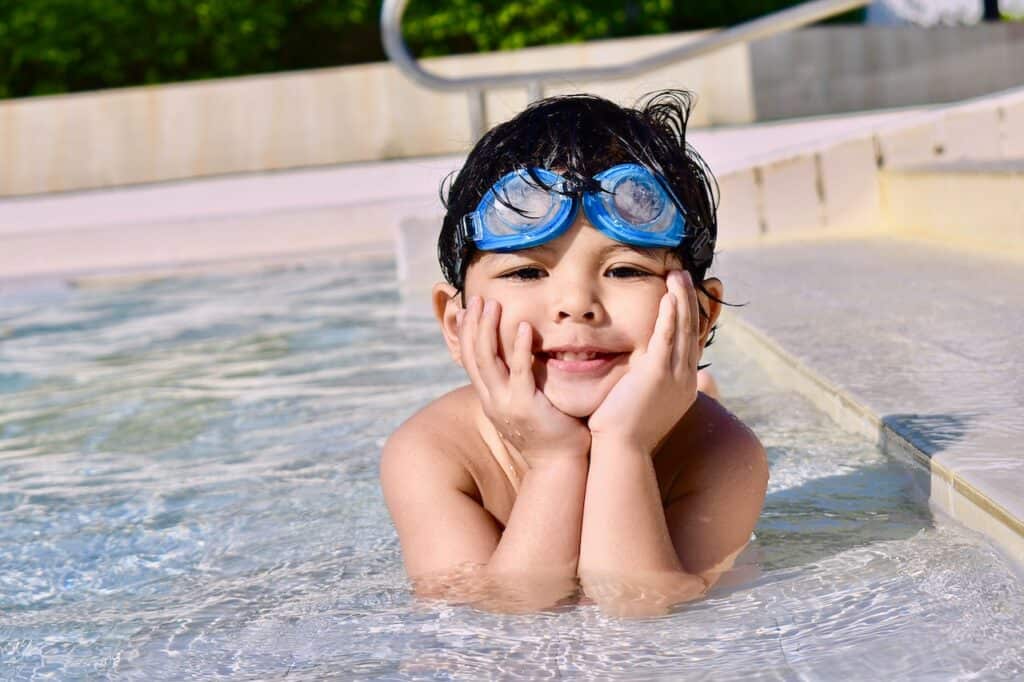
Use a Washcloth
Using a washcloth is a simple and effective way to clean a toddler’s body between baths. Wet the washcloth with warm water and gently wipe the toddler’s face, neck, arms, and legs. Pay special attention to areas that tend to get dirty, such as the hands and feet. If the toddler has sensitive skin, use a mild soap or skip the soap altogether.
Let Natural Oils Do Their Job
Toddlers have natural oils on their skin that help keep it moisturized and healthy. Bathing too frequently can strip these oils away, leaving the skin dry and irritated. Instead of giving a daily bath, consider giving a bath every other day or every two days. This will allow the natural oils to do their job and keep the skin healthy.
Keep Them Clean
Toddlers tend to get dirty quickly, whether they are playing outside or eating messy foods. It is important to keep them clean throughout the day to prevent the buildup of dirt and bacteria. Use wet wipes or a damp washcloth to clean the toddler’s face and hands after meals and snacks. Change their clothes if they get dirty or sweaty.
Be Mindful of Dirt
Dirt is a common culprit of toddler messes, but it can also be harmful if it gets into their eyes or mouth. Be mindful of dirt and try to keep the toddler away from areas that are particularly dirty or dusty. If the toddler does get dirty, clean them up as soon as possible to prevent dirt from getting into their eyes or mouth.
In conclusion, maintaining toddler hygiene between baths is important for keeping them clean and healthy. Using a washcloth, letting natural oils do their job, keeping them clean throughout the day, and being mindful of dirt are all effective ways to maintain toddler hygiene between baths.
Frequently Asked Questions
How often should I bathe my 3 year old?
It is recommended to bathe a 3 year old child around 2-3 times a week. However, if your child gets particularly dirty or sweaty from playing outside or participating in sports, you may need to bathe them more frequently.
How often should I bathe my 1 year old?
For a 1 year old child, it is generally recommended to bathe them 1-2 times a week. However, if your child gets messy from eating or playing, you may need to bathe them more frequently.
How often should a 5 year old bathe?
A 5 year old child should be bathed around 2-3 times a week. However, if your child is particularly active or gets dirty often, you may need to bathe them more frequently.
When should I start bathing my child every day?
It is not necessary to bathe a child every day until they reach puberty. Before that, 2-3 times a week is sufficient. However, if your child gets dirty or sweaty from playing outside or participating in sports, you may need to bathe them more frequently.
Should 3 year olds shower everyday?
It is not necessary for a 3 year old child to shower every day. Bathing them 2-3 times a week is sufficient. However, if your child gets particularly dirty or sweaty from playing outside or participating in sports, you may need to bathe them more frequently.
Is it OK to bathe with my 3 year old?
It is generally safe for a parent to bathe with their 3 year old child. However, it is important to ensure that the water temperature is not too hot and that the child is supervised at all times to prevent accidents.
Related Post: Baby Swallowing Bath Water Here’s a quick video on How Often Should You Bathe A Baby?

Iesha is a loving mother of 2 beautiful children. She’s an active parent who enjoys indoor and outdoor adventures with her family. Her mission is to share practical and realistic parenting advice to help the parenting community becoming stronger.





